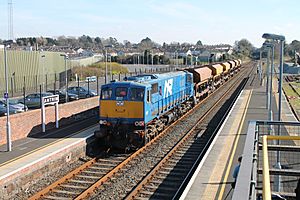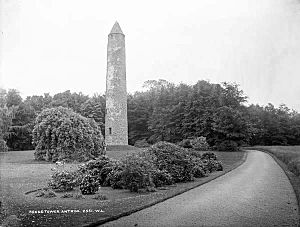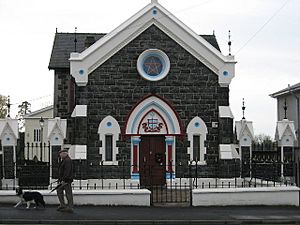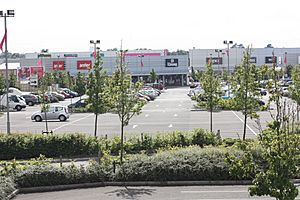Antrim, County Antrim facts for kids
Quick facts for kids Antrim
|
|
|---|---|
| Town | |
 All Saints Parish Church and bridge over the Six Mile Water |
|
| Population | 25,606 (2021 census) |
| Irish grid reference | J1588 |
| • Belfast | 19 miles (31 km) |
| District |
|
| County | |
| Country | Northern Ireland |
| Sovereign state | United Kingdom |
| Post town | ANTRIM |
| Postcode district | BT41 |
| Dialling code | 028 |
| Police | Northern Ireland |
| Fire | Northern Ireland |
| Ambulance | Northern Ireland |
| EU Parliament | Northern Ireland |
| UK Parliament |
|
| NI Assembly |
|
Antrim (Irish: Aontroim) is a town in County Antrim, Northern Ireland. It sits on the banks of the Six Mile Water river. It is also on the north-east shore of Lough Neagh. In 2021, about 25,606 people lived there. Antrim is the main town of County Antrim. It used to be the center for the Antrim Borough Council. Now, it's part of the Antrim and Newtownabbey Borough Council. The town is about 14 miles (22 km) northwest of Belfast. The name Antrim comes from an old Irish word, Aontroim, which means 'lone ridge'.
Contents
History of Antrim
Antrim's Early Beginnings
A monastery was started in Antrim way back in 495 AD. It was founded to continue the work of Saint Patrick. A small settlement grew up around this monastery. The tall round tower you can see today is all that remains of it. The original name for Antrim was Aontreibh. This Irish word meant 'lone house', referring to the monks' home. Later, it became Aontroim, meaning 'lone ridge'.
In the early Middle Ages, Antrim was part of a Gaelic area called Dál Araide. This area covered much of what is now County Antrim. On the eastern side of town, there is an old fort called Rathmore. This name means 'great fort' in Irish. It was once the royal home for the kings of Dál Araide.
In the late 1100s, new people called Anglo-Normans arrived. They were led by John de Courcy. They took control of the area. Antrim then became part of the Earldom of Ulster. The Anglo-Normans built a special type of castle called a motte-and-bailey castle in Antrim. The mound (or motte) of this castle can still be seen in Antrim Castle Gardens.
The Anglo-Norman earldom later fell apart in the early 1300s. Antrim then became part of a Gaelic territory called Clannaboy. During the later Middle Ages, the O'Neill chiefs of Clannaboy lived nearby. Their castle, Edenduffcarrick, was later known as Shane's Castle. It is about two miles west of Antrim.
Antrim in the Early Modern Era
After a big conflict called the Nine Years' War (1593–1603), Antrim came under English rule. English and Scottish settlers then moved to the area. This was part of a plan called the Plantation of Ulster.
A man named Hugh Clotworthy helped build Antrim Castle. This was a strong house next to the old Norman castle mound. Hugh was made a knight in 1617. He also became the High Sheriff of County Antrim. In 1642, during the Irish Confederate Wars, Clotworthy's ships fought a battle on Lough Neagh.
A group called the Society of United Irishmen started a rebellion in 1798. This rebellion began in Leinster and quickly spread to Ulster. The United Irishmen wanted to bring Catholics and Protestants together. Their goal was to end British rule in Ireland and create an independent Irish republic. Many of their leaders in northeast Ulster were Protestant Presbyterians.
On June 7, 1798, about 4,000 United Irishmen attacked Antrim town. They were led by Henry Joy McCracken. The rebels were close to taking the town. But then, British soldiers arrived to help. Thanks to a rebel group led by James Hope, most of the United Irishmen were able to leave safely. This event is known as the Battle of Antrim.
Before the Act of Union in 1801, Antrim sent two members to the Irish House of Commons. This was the Irish Parliament at the time. After 1801, it no longer had this right.
Steeple House was a large mansion from the 1700s. It was home to the Clark family. Later, it became the main office for Antrim Borough Council. Sadly, it was destroyed in a fire in July 2019.
Antrim During The Troubles
During a period of conflict known as "the Troubles", there were some difficult events in and around Antrim.
Antrim's Climate
Like the rest of Northern Ireland, Antrim has a maritime climate. This means it has cool summers and mild winters. The closest official weather station is at Belfast International Airport. This airport is less than 4 miles south of Antrim town.
In a typical year, the warmest day usually reaches about 25.4°C (77.7°F). About two days a year reach 25.1°C (77.2°F) or higher.
The coldest night of the year usually averages -6.6°C (20.1°F). About 39 nights a year have frost in the air. The lowest temperature ever recorded was -14.2°C (6.4°F). This happened during a very cold time in December 2010. That month, 10 nights were -10.0°C (14.0°F) or colder. On December 21st, the highest temperature during the day was only -7.7°C (18.1°F).
| Climate data for Belfast International Airport, elevation: 63 m (207 ft), 1991–2020 normals, extremes 1958–present | |||||||||||||
|---|---|---|---|---|---|---|---|---|---|---|---|---|---|
| Month | Jan | Feb | Mar | Apr | May | Jun | Jul | Aug | Sep | Oct | Nov | Dec | Year |
| Record high °C (°F) | 14.0 (57.2) |
15.6 (60.1) |
20.2 (68.4) |
21.8 (71.2) |
25.0 (77.0) |
29.5 (85.1) |
30.0 (86.0) |
28.0 (82.4) |
25.6 (78.1) |
21.8 (71.2) |
16.4 (61.5) |
15.0 (59.0) |
30.0 (86.0) |
| Mean daily maximum °C (°F) | 7.3 (45.1) |
7.9 (46.2) |
9.7 (49.5) |
12.3 (54.1) |
15.2 (59.4) |
17.6 (63.7) |
19.1 (66.4) |
18.7 (65.7) |
16.6 (61.9) |
13.1 (55.6) |
9.8 (49.6) |
7.6 (45.7) |
12.9 (55.2) |
| Daily mean °C (°F) | 4.7 (40.5) |
4.9 (40.8) |
6.3 (43.3) |
8.5 (47.3) |
11.2 (52.2) |
13.8 (56.8) |
15.4 (59.7) |
15.2 (59.4) |
13.2 (55.8) |
10.2 (50.4) |
7.1 (44.8) |
5.0 (41.0) |
9.6 (49.3) |
| Mean daily minimum °C (°F) | 2.1 (35.8) |
2.0 (35.6) |
3.0 (37.4) |
4.7 (40.5) |
7.1 (44.8) |
9.9 (49.8) |
11.8 (53.2) |
11.7 (53.1) |
9.9 (49.8) |
7.2 (45.0) |
4.4 (39.9) |
2.4 (36.3) |
6.4 (43.5) |
| Record low °C (°F) | −12.8 (9.0) |
−11.1 (12.0) |
−9.9 (14.2) |
−5.1 (22.8) |
−2.8 (27.0) |
−1.2 (29.8) |
2.2 (36.0) |
2.3 (36.1) |
−0.5 (31.1) |
−3.0 (26.6) |
−8.6 (16.5) |
−14.9 (5.2) |
−14.9 (5.2) |
| Average precipitation mm (inches) | 77.0 (3.03) |
63.3 (2.49) |
60.6 (2.39) |
55.6 (2.19) |
55.9 (2.20) |
68.0 (2.68) |
78.8 (3.10) |
84.5 (3.33) |
69.2 (2.72) |
88.0 (3.46) |
87.7 (3.45) |
83.5 (3.29) |
872.0 (34.33) |
| Average precipitation days (≥ 1.0 mm) | 14.7 | 13.2 | 13.0 | 12.0 | 11.6 | 11.9 | 14.1 | 14.2 | 12.1 | 14.0 | 15.5 | 15.2 | 161.3 |
| Average snowy days | 5 | 5 | 4 | 1 | 0 | 0 | 0 | 0 | 0 | 0 | 1 | 3 | 19 |
| Average relative humidity (%) | 89 | 87 | 88 | 89 | 90 | 90 | 90 | 92 | 92 | 91 | 90 | 89 | 91 |
| Mean monthly sunshine hours | 48.7 | 72.1 | 108.4 | 157.8 | 197.9 | 167.6 | 152.0 | 146.4 | 121.5 | 91.2 | 61.3 | 47.1 | 1,372 |
| Source 1: Met Office NOAA (relative humidity and snow days 1961–-1990) | |||||||||||||
| Source 2: KNMI | |||||||||||||
Antrim's Population
Antrim in 2021
On March 21, 2021, there were 25,606 people living in Antrim. Here are some facts about them:
- About 21% were under 16 years old.
- About 64% were between 16 and 65 years old.
- About 14% were 66 years old or older.
- About 51% of the people living there were female.
- About 48% were male.
- About 48% were from a Protestant or other Christian background.
- About 34% were from a Catholic background.
- About 2% were from other religions.
- About 14% did not have a religion.
- About 54% said they had a British national identity.
- About 36% said they had a Northern Irish national identity.
- About 14% said they had an Irish national identity. (People could choose more than one identity).
- About 9% knew some Ulster Scots.
- About 5% knew some Irish.
Antrim in 2011
On March 27, 2011, there were 23,375 people living in Antrim. This was an increase of about 17% from the year 2001.
- About 21% were under 16 years old.
- About 13% were 65 years old or older.
- About 48% of the people living there were male.
- About 51% were female.
- About 54% were from a Protestant or other Christian background.
- About 34% were from a Catholic background.
- About 61% said they had a British national identity.
- About 30% said they had a Northern Irish national identity.
- About 11% said they had an Irish national identity. (People could choose more than one identity).
- The average age of the people was 35 years.
- About 8% knew some Ulster Scots.
- About 5% knew some Irish.
Antrim's Landmarks
- Shane's Castle and Antrim Castle: These are two important castles in the area.
- Antrim Round Tower: In the north of the town, there is one of the most complete round towers in Ireland. It is 93 feet (28 meters) high. It is 50 feet (15 meters) around at its base. It stands in the grounds of Steeple. There is also a prehistoric stone called the "Witches' Stone" there.
- Old Antrim Castle: There was an old castle near the Six Mile Water river. It was destroyed in a fire in 1922. Only an eight-sided tower remains today.
- Linen Industry: The river helped the linen industry grow in Antrim. Today, a Technology Park has replaced the linen industry. It is the only one of its kind in Northern Ireland.
- Antrim Market House: This is a two-story building built in 1726. It used to be a Court House. It has been updated and is now a tourist information center. It also has a small theater and a café.
- The Castle Grounds: These beautiful gardens are next to where Antrim Castle used to be.
- The Springfarm Rath: This is another ancient ringfort in the area.
Transport in Antrim

- Antrim Railway Station: This train station opened on April 11, 1848. It stopped being used for goods in 1965. Passenger trains from Northern Ireland Railways still use it. They run on the Belfast-Derry railway line.
- Belfast International Airport: Antrim's Aldergrove Airport is also known as Belfast International Airport. It is the biggest airport in Northern Ireland. It has flights to places in Britain, Europe, and North America. However, Aldergrove does not have a direct train connection.
Shopping in Antrim
- The Junction: This is a large shopping area. It used to be called Junction One. It is named after junction 1 of the nearby M22 Motorway. It has many shops, restaurants, and a hotel.
- Supermarkets: You can find several big supermarkets in Antrim. These include Asda, Lidl, Tesco Extra, and Iceland.
- Castle Mall: This shopping center is on High Street in the town. It used to be called the Castle Centre.
Education in Antrim
Antrim has several junior schools:
- Antrim Primary School
- Ballycraigy Primary School
- Greystone Primary School
- St Comgall's Primary School
- St Joseph's Primary School
The secondary schools in Antrim are:
- Antrim Grammar School
- Parkhall College
- Some students from Antrim also go to St Benedict's College, Randalstown.
The Greenmount campus of the College of Agriculture, Food and Rural Enterprise (CAFRE) is also near Antrim.
Sports in Antrim
- Gaelic Games: The local Gaelic Athletic Association club is Naomh Comhghall CLG (St. Comgalls Antrim).
- Football: The association football club is Chimney Corner F.C.. They play their home games at Allen Park.
- Other Clubs: Other sports clubs in Antrim include Antrim Hockey Club and Muckamore Cricket Club.
People from Antrim
- Mark Allen (born 1986) – a snooker player.
- Declan Kearney (born 1964) – a Sinn Féin politician and MLA.
- Thomas McCord (1750–1824) – a businessman and politician in Lower Canada.
- Eva McGown (1883–1972) – the Official Hostess of Fairbanks and Honorary Hostess of Alaska.
- Joseph Stephenson-Jellie (1874–1960) – a cricketer.
- Josh Rock (born 2001) – a darts player.
See also
 In Spanish: Antrim para niños
In Spanish: Antrim para niños





